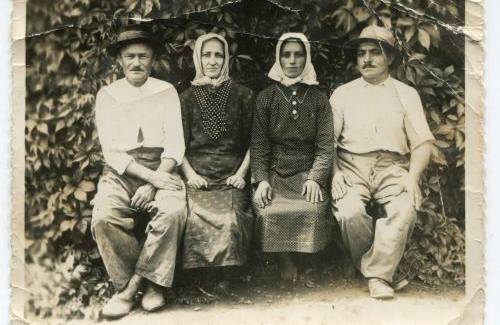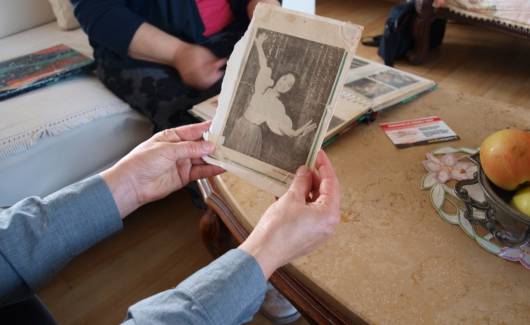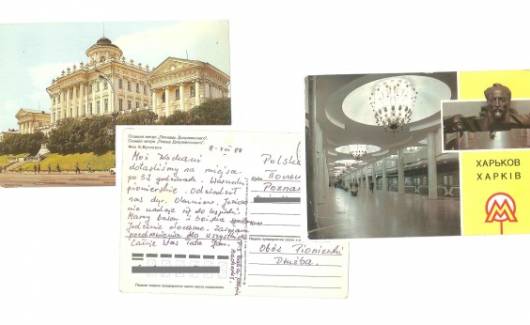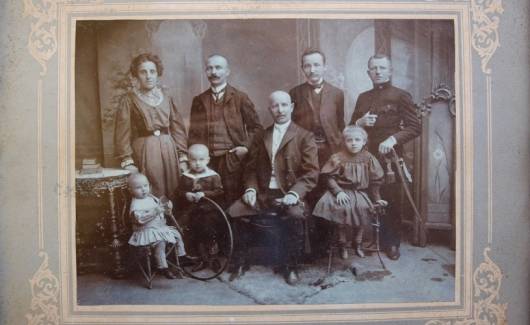Scientific consultant: Professor Anna Engelking, Institute of Slavic Studies of the Polish Academy of Sciences
“Were Europe to have its collective memory,
it is as diverse as Europe’s nations and cultures”
Claus Leggewie
Introduction
The project entitled “In Between? Searching for Local Histories in Borderlands of Europe” was born out of the need to experience local histories. In terms of its objectives, it is primarily an educational measure, and indirectly also a research and documentation effort. Its aim is to search for ways in which the past functions today. It is an attempt at looking at memory of the past in its individual dimension, between members of a single family (both as an intergenerational and intercultural experience), between various families within the same community or between various groups composed of communities with their often contradictory experiences and identities shaped by them.
The framework for this pursuit will be the in between category, broadly understood as being in between in terms of identity. The search for local histories will make it possible to enter an area of identity-shaping factors and activities, which consequently have an impact on shaping relations between people as members of various groups. Stories, recollections but also daily practices which may derive from past events will be the basis for reflexion on the local dimensions of the in between phenomenon.
The project is to be a pretext for young Europeans to experience the “borderland”, both in geographical or political and cultural, social and intergenerational terms. It will also be an opportunity to discover individual and collective memories, yet primarily to meet the “Other” and to listen to their story in the context of the dramatic events of the 20th and 21st centuries, resulting in reconfigurations of individual and collective identities. The places visited saw tragic events play out in the past (e.g. repressions, forced resettlement, the Holocaust), which affected not just individuals or families but entire communities and had a vital impact on the shaping of local identities.
We believe that by linking a research-oriented approach to the reality under observation (related to the carrying out of ethnographic field studies: participant observation and biographical interview) with historical examination of the past will help the participants of the "In Between?" project better understand the people they meet on their way.
During a week-long stay in one of four regions and meetings with specific families, the participants of the "In Between?" project will, in international teams, collect preliminary documentation, to let them express their subjective understanding of the notion of in between using their own voices. In December 2016, they will all convene at a summary seminar, to yet again look at their borderland experience acquired in the field.
Project objectives
Identity and in between
Identity is one of the key terms in the “In Between?” project. Understood as a sense of belonging to a certain group, it is created when in contact with the “Other” (Eriksen 2009). It must be remembered that everyone has got a number of parallel and not mutually exclusive social identities and it is only the context that determines which ones are activated/used at any given time. And so identity is not constant, but constantly created and negotiated in contact with others. According to Fredrik Barth, for ethnic identity to survive it must be solidified in social situations in which one participates. Such areas are most frequently religion, language, work or marriage (Barth 1969). This definition can be extended from the ethnic dimension to the universal understanding of identity, which can be perceived as a constant social practice in which individuals take part and through which they define themselves, and the in between state, being in a borderland, assumes in this case the existence of two or more social groups or spaces between which one is or happens to be. Such constant negotiations as to one’s belonging can be expressed by making specific choices or by specific daily practices.
In the “In Between?” project, there are many dimensions of being in between to be discovered by the participants. First and foremost, it will be the individual level. Then the family followed by relations between individual families (but also individuals) in a given region, and then between various groups: ethnic, religious, cultural, linguistic or social. The project is to be an attempt at finding an answer to the question what such being in between can be in particular local contexts. Work in international teams in specific spaces, primarily based on studying communities, their histories and contemporary practices of daily life, yet also referring to the participants’ knowledge and experience, will be an opportunity to jointly interpret the phenomenon in question. Meeting people who live in spaces “between” will not only facilitate a search for answers as regards the essence of the in between state but also show a multitude of possible interpretations, perspectives and experiences of the phenomenon in various European regions. This is also an opportunity to reflect on the “borderland” category. What can it signify today? Where can it be found in the dynamically changing reality where one has got a number of parallel coexisting and constantly negotiated identities? Whether and how can the notion of borderland be implemented in a transcultural world described by Wolfgang Welsch, where cultures are not homogenous or separate any more but constantly influence each other and merge? To what extent is transculturality a state of being in between? This is also a question concerning identity: who are we? Who are they and how do they define themselves?
Another category whose contemporary ways of functioning can be examined by implementing the “In Between?” project is “in-betweenness”[1] (Jackson II 2010), understood as a hybrid identity (Jorge 2008). It assumes that an individual with some migration experience in the post-colonial era exists between two national identities – the current one where he/she does not fully belong and the past one where he/she cannot return. The displacement experience equips the individual in recollections going beyond the narrow boundaries of national belonging. Can this term, created on the basis of post-colonial studies, serve as a tool for interpretation of the situation of individuals in Central Europe[2]? How can experiencing conflict and interaction between one culture and another (or a set of values, principles) function in heterogeneous communities? Can, and how, be this hybrid identity extended from individuals to families?
Another important notion behind the “In Between?” project is the “borderland” from its title. Europe means hundreds of various “borderland” spaces. Scholars call for a separate subdiscipline focusing on the issue (e.g. anthropology/sociology of borderlands). Researchers are moving away from the geographical meaning focusing on its cultural and social meaning. Grzegorz Babiński says that “contemporary borderlands, and now maybe only boundaries of national cultures, are often only subjective and symbolic in nature, as frequently there are not even linguistic differences there” (Babiński 1999). Andrzej Sadowski, in turn, claims that “borderlands are becoming increasingly subjective, symbolic, defined by the identities and identifications expressed by their inhabitants” (Sadowski 1999). In the context of the “In Between?” project, the perspective postulated by Justyna Straczuk is also inspiring, seeing borderland as a communication community, “which develops in the course of daily life, a cultural amalgamate which constitutes an integral entity with a wider repertoire of elements coming from traditions meeting” (Straczuk 2004). The project is going to be an opportunity to check how that “communication community” is shaped in different families. Is borderline, and how, subject to different interpretations made by members of different communities or groups? The project will also offer a chance to search for answers to the question “whether borderland man exist”. What shapes his identities6? How are relations built between borderland people? What role is played by past and current migrations, motivated by various factors, in shaping local identities?
The Past
“Each 'present' brings together movements of different origin and different rhythm. Today has its roots at the same time in yesterday, the day before yesterday, and some time ago,” wrote Fernand Braudel (Braudel 1971, p. 60) in his book Textes des ecrits sur l'histoire. The past and memories superimposed onto each other shape various identities which function in parallel. In order to discover that wealth and diversity of identities one must watch those individual and local memories in their qualitative and miniature (rather than global and quantitative) dimension.
With such objectives in mind, it seems useful to invoke the microhistorical approach postulated by Carlo Ginzburg and Carlo Poni in 1979. Trying to grasp the reality of the historical world, they were looking for the “normally extraordinary” in the lives of ordinary people (Ginzburg, Poni, 1979, after: Domańska 2005). It was, on the one hand, moving away from great narratives, and on the other exploring history from the perspective of an individual or a small community. (Domańska 2005). Microhistory “tells a story of man thrown into the world, of human existence in the world, human experience of the world and ways to experience it. It is then a history of experiences, feelings and private microcosms. Man and his fate are encountered by means of cases, “miniatures”, anthropological stories which let one enter the daily reality like a probe” (Domańska 2005). Observing all that is ordinary and mundane lets one search for answers as to being in between in its most daily but also particular dimension. Culinary practices, religious practices, one’s relation with their body, educational or professional choices, language, matters of kinship – the in between state may be manifested in these and many other areas. Depending on the history of a given person or family, they can come into being in various configurations.
When exploring or documenting individual, familial or local histories, one must be aware of the relation between history and social memory as well as individual memory. In the “In Between?” project, “memory” will be treated not just as a tool for discovering knowledge about the past and knowledge about borderlands but manly as a source of knowledge about the in between state and the identities being discovered (Kaniowska 2003)[3], as it is memory that creates one’s identity. Memory is a source of knowledge about man, as it accumulates and consolidates his/her experiences (Kaniowska 2003 after: Ingarden 1995). A study of identity is a study of the memory (i.e. narrative about the past) of those who are at the same time the main characters and authors of the story and who fill that past with meaning through the need to remember it and transfer it on (Kaniowska 2003).
This is confirmed by the postulates put forward by Maurice Halbwachs, who has claimed that memory is no mechanical remembering of facts but their reconstruction in a certain framework offered by the community[4] one is a member of. “In society, man typically acquires recollections, recognises and locates them” (Halbwachs 2008) – without a group individuals would not attach to past events meanings which would allow to ascribe them the role of events worth remembering. Individuals remember when adopting a collective point of view – they remember what the group wants to be remembered. There are as many various memories as there are groups. At the same time, social memory (as memory of a group) materialises and manifests itself in individual memories (Halbwachs 2008).
Methodology
In the “In Between?” project we do not define areas – identities that we want to explore. We do not want to limit the search to one’s national, ethnic, religious or linguistic identity. This may also be an experience of migration or social roles. Assuming that identities are multidimensional and constantly constructed anew, we leave a space for the young researchers so that they can find themselves in between areas of most interest to them. While guided by the anthropological assumption of openness to what one meets in the field – we do not want to impose the study framework in advance.
The “In Between?” project will be carried out based on the “oral history” method, i.e. collecting stories about lives of ordinary people, participants of and witnesses to past events. This working method based on recording (audio or video) and making transcripts of the testimonies lets one see history and reality through the eyes of an individual. Listening to interpretations of particular facts, the researcher can appreciate the multidimensionality of phenomena which seems obvious at first. It also helps examine identity by exploring the conditions of one’s religious, cultural, territorial or social belonging. All those elements constitute the research area in the “In Between?” project.
In the case of this method, the descriptive dimension is not less important. Interviews are not merely dry declarations of belonging or participation. They are narratives, which facilitate sketching out a context and introducing reality of daily practice and actions.
One must obviously be aware of the controversy surrounding this mode of work. Memory is not just a list of facts but an internally and externally conditioned interpretation of the importance of events and individual experiences. However, what may be a disadvantage to some, should be treated as a gain in this case. Traditional historical methods based primarily on analysis of found sources appear to be less effective in search of individual experiences of the in between state than induced sources. The use of audio and video recordings will allow the project participants to work creatively on the interpretation of the materials collected.
We want to search for the essence of in between mainly in individuals and families, hence our focus on memory in these two dimensions. We are going to talk about both important events in the history of individuals and families and about daily life (also understood as annual and family festivities). We would also like to know the impact of the sense of being a cultural minority or holding the official status of a minority on the sense of being in between. What problems does it entail? What privileges? How does an individual/family function in relations with authorities (locally but also in terms of the state)?
The search for an answer as regards the ways of being in between will be a combination of the oral-history method with ethnographic and anthropologic methods. These will not be, however, classic, long-term stationary studies of a local community but rather qualitative studies based on interview (biographical, autobiographical narrative interviews and interview by questionnaire) and analysis of family memories or local/group memories, and remembrance practices. The essence of anthropology is a detailed understanding of a phenomenon through field research treated as the most important source of knowledge (Eriksen 2009). The in between state is just such a phenomenon the project participants will strive to become familiar with and comprehend.
As remembrance practices we understand various activities undertaken in order to preserve, transfer and manifest the past. In the familial dimension, this may be collected archives and keepsakes. Interesting and inspiring activities may be performed with photographs or objects attributed sentimental/personal/family value. They can be collected in albums, displayed at home or for various reasons handed over to museums, halls of remembrance or archives. They can also be symbolically destroyed in an attempt to sever one’s ties with the past. At group level, these may be various activities performed in the public space or virtual space. This is confirmed by Pierre Nora, who claims that memories are rooted in specific group contexts – in specific places, practices, gestures, images or objects (Nora 2009). Such diverse activities may also be the starting point for a search for different variations of the in between state.
In memory studies, a major role is played by the division into different types of memory – primarily that into individual and collective memories. What also matters is the role of the family and intergenerational memory transfer. This is pointed out by Jan and Aleida Assmann, German memory researchers. Jan Assmann has made the distinction between communicative memory and cultural memory, the former based on experience and biographical and factual in nature. It is shared by a single (participating or witnessing) generation which can emotionally transfer it to its children (as successive generations). So transmitted, it can last 80-100 years, with the family playing the key role in the process. In time, the need appears to institutionalise that communicative memory transferred through generations. Then its preservation in a specific form becomes important. To that end, archives and museums are set up, and various performing arts appear which lend specific forms to memory of the past. In this way, cultural memory develops (Assmann 2008).
Aleida Assmann, in turn, differentiates between individual memory and that of generations (the latter appearing as a result of experience transfer within the family, i.e. between generations) as well as collective (national-political) memory and cultural (archival) memory (Assmann 2013). The two first mentioned could be classified as communicative memory and the other two as cultural memory according to the division postulated by Jan Assmann. In the “In Between?” project, the young researchers will be able to both focus on one of the proposed memory dimensions and explore the relations developing between various memory dimensions in specific communities. This may be particularly interesting in the context of accounting for the power relations between the dominant group and a minority group which can compete or support each other in remembrance practices in many different ways.
In the case of becoming familiar with local memory/history of the twentieth century, particularly in trauma-affected communities, it is worthwhile to take into consideration the category of “postmemory” (a term coined by Marianne Hirsch). This marks an important distinction between the memory of a direct witness or participant and the memory of successive generations, not so clearly highlighted in Jan Assmann’s notion of communicative memory. In the case of postmemory, the contemporary generations are not/have not been witnesses to the most tragic events of the twentieth century. They are more of recipients and transmitters of mediated content – both in the form of direct accounts and – mainly – texts of culture/products of culture (films, books, museums, monuments, etc.). This is mediated memory, “a relation linking the generation that participated in the experience of a cultural or collective trauma with the successor, which ‘remembers’ it only thanks to stories, images and behaviours making a context for their growing up. This experience has been transferred to them in such an emotional manner that it appears to be a foundation of their own memory.”(Hirsch 1993)
Summary
For us, this physical and intellectual (research-related) discovery of borderlands and the in between phenomenon has a dimension of experiencing otherness to it. Apart from showing that life can be different, being on the periphery and meeting “Others” makes us conscious of being immersed in our own culture. In turn, microhistory – qualitative and miniature, not global and quantitative (Domańska p. 244) – lets us hear polyphonic diversity (Hans Medick). Such an approach shakes us out of the safe position of the only legitimate narrative leading on to a path of dialogue-based memory, which makes it possible to accommodate in one’s own memory not just one’s own suffering but also that of others (including that caused by ourselves) (A. Assmann 2011). This resembles the agonistic mode of remembering[5], which makes it possible to draw on experiences of many different event participants (victims and perpetrators of violence as well as observers). It offers a possibility to express the multitude of past experiences and accept them. Both approaches let us build the foundations of solidarity with others on the basis of reflexion and dialogue.
The project participants are free to choose the forms in which to eventually present their interpretations of the in between phenomenon. These may be texts, but also video-notes, audio recordings, photo documentation or animation-performance acts. Thanks to the diversity of the media and the participants’ competences, we wish to showcase the multidimensionality of experiencing the in between in individual, family, group, local, but also intercultural, intergenerational and European dimension.
References
Andrade Fernandes, Jorge Luis. Challenging Euro-America's Politics of Identity: The Return of the Native. London: Routledge, 2008.
Assmann, Aleida. Miedzy historią a pamięcią. Antologia [Between History and Memory. Selected Texts]. Warsaw: Wydawnictwa Uniwersytetu Warszawskiego, 2013.
Assmann, Jan. Pamięć kulturowa. Pismo, zapamiętywanie i polityczna tożsamość w cywilizacjach starożytnych [original:Cultural Memory and Early Civilization: Writing, Remembrance, and Political Imagination]. Warsaw: Wydawnictwa Uniwersytetu Warszawskiego, 2008.
Babiński, Grzegorz. “Pogranicza etniczne i kulturowe” [Ethnic and cultural borderlands]. Marian Malikowski, Dariusz Wojakowski (eds.), Między Polską a Ukrainą. Pogranicze – mniejszości, współpraca regionalna. Rzeszów: Mana, 1999.
Braudel, Fernand. Historia i Trwanie [original: Textes des ecrits sur l'histoire]. Warsaw: Czytelnik, 1971.
Cohen, Anthony. Symbolic Construction of Community. London, NY: Routledge, 1985.
Domańska, Ewa. Mikrohistorie: spotkania w międzyświatach [Microhistories: meetings in interworlds]. Poznań: Wydawnictwo Poznańskie, 2005.
Eriksen, Thomas. Małe miejsca, wielkie sprawy [original: Small Places – Large Issues]. Warsaw: Oficyna Wydawnicza Volumen 2009.
Halbwachs, Maurice. Społeczne ramy pamięci [original: Les cadres sociaux de la mémoire]. Warsaw: Wydawnictwo Naukowe PWN, 2008.
Hirsch, Marianne. “Family Pictures: Maus, Mourning and Post-Memory. Discourse. 15, no. 2 (1992 – 1993) (1993).
Jackson II, Ronald L. Encyclopaedia of Identity. London: SAGE Publications, 2010.
Kaniowska, Katarzyna. “Antropologia i problem pamięci” [Anthropology and the notion of memory]. Konteksty. Polska Sztuka Ludowa, LVII 2/3, pp. 57-65 (2003).
Pierre, Nora. “Between the memory and history: Les Lieux de Mémoire”. Working Title: Archive, no. 2, pp. 4-12, 2009.
Sadowski, Andrzej. Tożsamość. Identyfikacja. Pogranicze” [Identity, Identification. Borderland]. Sadowski Andrzej, Mirosława Czerniawska. Tożsamość Polaków na pograniczach, Białystok: Wydawnictwo Uniwersytetu Białostockiego, pp. 11-32, 1999.
Straczuk, Justyna. Cmentarz i stół. Pogranicze prawosławno-katolickie w Polsce i na Białorusi [The cemetery and the table. The Orthodox-Catholic borderland in Poland and Belarus]. Wrocław: Wydawnictwo Uniwersytetu Wrocławskiego, 2006.
[1]Individuals who experience „in-betweenness” face continuous negotiations between being here and there, themselves and others, thereby creating their hybrid cultural identity.
[2]Whose history can also be examined from the perspective of post-colonial criticism.
[3]According to K. Kaniowska, in anthropology memory plays various roles: of a source, a subject and a tool.
[4]A family can be perceived as a community.
[5]The modes of memory were discussed by David Clarke during the conference “Genealogies of Memory” organised by the European Network Remembrance and Solidarity in Warsaw in December 2015.




